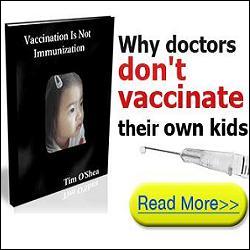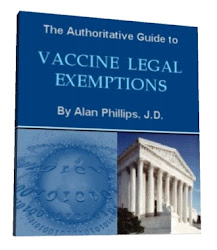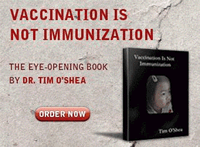This Mama Isn’t Scared of the Shmeasle Measles
by Megan Heimer, NHE, JD, ND
First the flu, then pertussis, then mumps, polio, and now predictably…the shmeasle measles. I know what you’re thinking:
Gasp! Did she just make a play on words with a horrifying, deadly disease? Doesn’t she know that measles is at an all-time high during the first five months of the year since like…2000?
Yes, I totally did, and please say that last sentence out loud because it is as ridiculous as it sounds. Dealing with the inconsistencies and derogatory “anti-vaxxer” rhetoric makes me feel like I’m up to my knees in cow poop and in desperate need of some muck boots. Am I scared of my child getting measles? Absolutely not. Am I scared of the MMR vaccine…you better believe I am. You would be too if you were getting the facts…the real facts.
(Sh)measles Inconsistencies
According to the CDC’s most recent Morbidity and Mortality Report (MMWR) measles is a “highly contagious, acute viral illness that can lead to serious complications and death.” Of course, prior MMWRreports and the CDC’s manual of surveillance leave out that last part; but since we’re trying to scare people into vaccinating their children, this 2014 gem of a report decided to adopt a global view and kick the emotions up a notch to let you know what’s at stake…death.
Widget not in any sidebars
If you’ve been watching the media, subscribing to anti-vaxxer hate articles, or just so happen to come across the World Health Organization statistics, you’ll see that 122,000 people die from measles globally each year. Scary right?
Yet, on that same MMWR report the CDC lists the clinical definition for measles as “an illness characterized by a generalized rash lasting ≥3 days, a temperature of ≥101°F [≥38.3°C], and cough, coryza, and/or conjunctivitis.” In other words, a rash, cough, and fever is how measles typically presents at the doctor’s office here in the United States, and this is the clinical definition used on all of their reports and surveillance data. Do you know how many people die each year from measles in this country? About zero.
So which is it? A deadly disease…or a rash? Well, it depends on whether we’re using global statistics. If you’re not, it’s a rash. If you’re trying to sensationalize a disease and fear monger people into vaccinating their kids with one of the most controversial vaccines there is…it’s an earth-shattering, beyond words terrifying, deadly disease. Except that it’s not…not in America anyway, and it’s not hard to see why.
According to the World Health Organization,
Severe measles is more likely among poorly nourished young children, especially those with insufficient vitamin A, or whose immune systems have been weakened by HIV/AIDS or other diseases. [..] As high as 10% of measles cases result in death among populations with high levels of malnutrition and a lack of adequate health care. […] More than 95% of measles deaths occur in countries with low per capita incomes and weak health infrastructures. […] Overcrowding in residential camps greatly increases the risk of infection.
 I hate to point out the obvious here, but we do not live in a third world country. But hey, if I walk out my front door in the morning and step onto a dirt road that’s never seen trash service or a sewer system, and is crowded with millions of starving people, I’ll let you know.
I hate to point out the obvious here, but we do not live in a third world country. But hey, if I walk out my front door in the morning and step onto a dirt road that’s never seen trash service or a sewer system, and is crowded with millions of starving people, I’ll let you know.
Seriously, applying global statistics of developing countries to the United States is like doing an obesity campaign in Africa based on U.S statistics. Yes, it’s completely rational to compare the second fattest nation in the world to a starving country. The three leading causes of death in this country (heart disease, cancer, and our own healthcare system) are not the leading causes of death in third world countries. Actually, in developing countries measles doesn’t even make the “top 10″ list. 122,000 people die from measles globally but over a half a million people in low-income countries alone, die from road traffic accidents. Do they make a vaccine for that?
I’m not trying to downplay death here, but I think it’s ironic that we use global statistics when it suits us, chalk up the decline of disease in this country to the vaccine, overlook the comparisons between an industrialized country and a developing one, and completely ignore the fact that the MMR vaccine is associated with severe adverse reactions including death, which is happening at a far higher rate in this country.
The Schmeasle Facts
In comparison, the same cannot be said for the MMR vaccine. As of March 1, 2012 there were 842 serious injuries following the MMR vaccine and 56 deaths. Since 1990 there have been more than 6,058 serious adverse events reported to the Vaccine Adverse Events Reporting System (VAERS). What’s even more sad is that only 1-10% of cases are actually reported on this database. Oh now I remember, statistics are only important as it relates to measles cases…not MMR adverse reactions. And of course, the global MMR death statistics aren’t important either.
But measles can cause blindness…so can the MMR vaccine.
But measles can cause encephalitis…so can the MMR vaccine
But measles can cause pneumonia…so can the MMR vaccine.
But if I don’t get vaccinated, I could get measles…If you do get vaccinated you can get measles, both from the vaccine, and later in life when immunity has disappeared. The CDC says that 5-10 percent of people vaccinated with MMR will develop a fever and rash. This means there are 650,000-1,300,000 cases of vaccine-induced measles in the U.S each year based off of the 13-14 million doses given to one-year-olds.
Death from various, and in some cases unknown, causes has been reported rarely following vaccination with measles, mumps, and rubella vaccines […]. – MMR Vaccine insert
But if my child gets measles…they could die. Given U.S statistics, they’re more likely to die from the MMR vaccine.
 But the measles vaccine has prevented so many deaths. Wrong. Read the chapter on measles from this book. We’ve been duped. Secondly, it’s impossible to test whether a vaccine prevented a death. You’d have to assume that if there were an outbreak of measles, everyone would get it, and you’d have to assume that everyone vaccinated against measles would have immunity.
But the measles vaccine has prevented so many deaths. Wrong. Read the chapter on measles from this book. We’ve been duped. Secondly, it’s impossible to test whether a vaccine prevented a death. You’d have to assume that if there were an outbreak of measles, everyone would get it, and you’d have to assume that everyone vaccinated against measles would have immunity.
But the measles vaccine has been proven safe and effective. Wrong again. But hey, call me up when someone does a double-blind (saline/inert) placebo controlled study on this vaccine, and let me know when “effective” means “life-time immunity.”
But if you don’t vaccinate, my baby who is too young to be vaccinated will be at risk. You’ve heard it, I’ve heard it:
Unvaccinated people put themselves and others at risk — particularly infants too young to be vaccinated, who can have the most severe complications. – Anne Schuchat, MD
Absolutely not true. What puts our babies at risk is the waning immunity that comes from a highly vaccinated population. You know what would give your baby a good dose of protection for the first year of their life? You guessed it, a mother whose been exposed to wild measles who then passes on these antibodies to protect her baby for the first year of life. Actually, medical literature suggests this protection could last up to 10 years. Imagine that.
The Benefits of Natural Exposure to Wild Measles
A measles rash as a child could yield protection against cancer as an adult (The Lancet, Bluming 1971, Pasquinucci 1971, Taqi 1981) and may provide protection against degenerative diseases of bone and cartilage, sebaceous skin diseases, immunoreactive diseases and certain tumours.
And, if you believe the hype about the measles vaccine that can treat cancer, then you have to acknowledge the fact that the real virus can do the same – and without the need to inoculate the equivalent of 10 million people with a genetically engineered teenage mutant ninja measles virus.
The Risks v. the “Benefits”
 So we have measles, which is associated with a red, itchy, rash, a runny nose, and a cough, that gives lifetime immunity, protection against more serious diseases as adults, and allows a mother to pass these antibodies to her baby for protection during their first year of life…or you have the MMR vaccine, which only provides temporary (if any) immunity, and could cause the following possible adverse reactions:
So we have measles, which is associated with a red, itchy, rash, a runny nose, and a cough, that gives lifetime immunity, protection against more serious diseases as adults, and allows a mother to pass these antibodies to her baby for protection during their first year of life…or you have the MMR vaccine, which only provides temporary (if any) immunity, and could cause the following possible adverse reactions:
Panniculitis, atypical measles, fever, syncope, headache, dizziness, malaise, irritability, vasculitis, pancreatitis, diarrhea, vomiting, parotitis; nausea, diabetes, thrombocytopenia, purpura, regional lymphadenopathy, leukocytosis, anaphylaxis, arthritis, arthralgia, myalgia,encephalitis, encephalopathy, measles inclusion body encephalitis, subacute sclerosing panencephalitis, Guillain-Barré Syndrome, acute disseminated encephalomyelitis, seizures, convulsions, polyneuritis, polyneuropathy, ocular palsies, paresthesia, asepticmeningitis, pneumonia, pneumonitis, sore throat, cough, rhinitis, Stevens-Johnson syndrome, erythema multiforme, urticaria, measles-like rash, pruritus, nerve deafness, otitis media, retinitis, optic neuritis (i.e. blindness), papillitis, retrobulbar neuritis, conjunctivitis, epididymitis, orchitis, and death.
Yeah, but didn’t you see that scary picture of child who had measles on like…every media news source?
Yeah, I did, and I wanted to congratulate this kid’s immune system. You see, the measles virus doesn’t cause the rash. This rash is physical evidence of cellular immunity destroying virus-containing cells and it’s extremely important. In other words, this scary rash is a byproduct of T-cells neutralizing the measles virus, without it our children could die or be exposed to far worse diseases as adults.
The reason children in third world countries die from measles is because they are malnourished or have impaired cellular immunity and cannot neutralize the virus (via a rash), because they are vitamin A deficient (which according to the WHO can reduce the number of deaths from measles by 50%); or because we’re vaccinating small children with MMR while they have measles protective antibodies from their mother still in their bodies.
The MMR Vaccine
Here are pictures of two other children post MMR vaccine.
Seriously, the vaccine you get to protect your children from measles…did that. The MMR vaccine has also left children disabled, paralyzed, chronically diseased, and dead…both here and in third-world countries.
 Of course, we only associate the MMR vaccine with autism. The big argument is that (a) MMR isn’t associated with autism, and (b) it could be, but the deadly threat of measles is more dangerous than a lifetime of autism…so for the sake of everyone we should all vaccinate. Whether you believe in the connection between MMR and autism, or not – if there is even the slightest chance that the MMR vaccine triggers any disease, we should not be injecting any child with this vaccine. A mild, unpleasant measles rash pales in comparison to ALL of the possible adverse MMR reactions.
Of course, we only associate the MMR vaccine with autism. The big argument is that (a) MMR isn’t associated with autism, and (b) it could be, but the deadly threat of measles is more dangerous than a lifetime of autism…so for the sake of everyone we should all vaccinate. Whether you believe in the connection between MMR and autism, or not – if there is even the slightest chance that the MMR vaccine triggers any disease, we should not be injecting any child with this vaccine. A mild, unpleasant measles rash pales in comparison to ALL of the possible adverse MMR reactions.
We’ve Heard It All Before
The media measles propaganda is not a new phenomenon. In 1996, 2008, and 2011, measles was at an “all-time-high” and the unvaccinated were to blame (as usual). But yearly statistics fluctuate and the majority of outbreaks regardless of the year occur in travelers who come back from other countries. Each year measles also occurs in the vaccinated, and outbreaks overall are highest in the most vaccinated states including New York, California, and (this year), Ohio; states which all – theoretically, should be protected by the “vaccine-induced” herd immunity. Oh yeah…that. What’s even more alarming is that the majority of people who do get measles nowadays are older. You can thank vaccines for that.
I don’t want my child to ever get sick, but you can’t convince me that the faulty, temporary immunity cooked up in Dexter’s laboratory which shifts exposure of measles to the youngest and the older most at-risk populations, causes serious vaccine adverse reactions, contains viruses and toxic ingredients that would put a parent in jail if they made their kids ingest these them individually, and yields nothing short of junk protection, is superior to natural immunity. I’m all for evidence-based medicine, but I draw the line at “bad evidence.”
I’m not vaccinating my children. No way. No how. Not ever. This mama isn’t scared of the shmeasle measles.
Megan Heimer is an attorney, traditional naturopathic doctor, registered yoga teacher, certified natural health educator, and has a bachelors degree in political science. She’s married to a Physician and blogs about all things alternative medicine, whole foods, healthy living, and attachment parenting at www.LivingWhole.org where this article first appeared.







